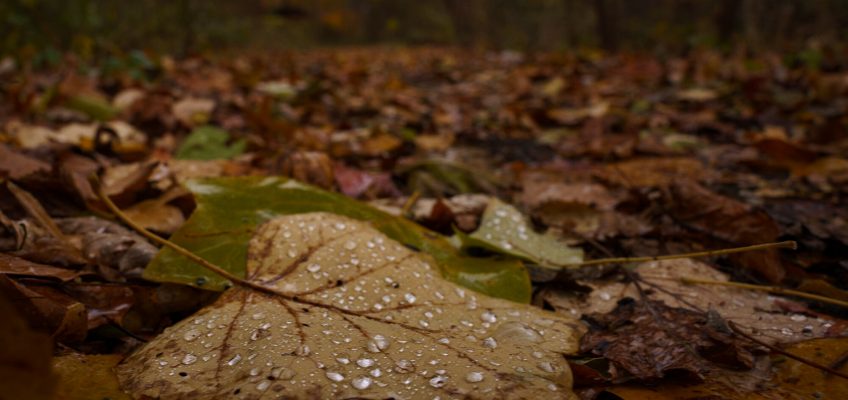The report is the first to quantify the stormwater capture capacity of the city’s forests, wetlands, and grasslands—helping prevent untreated sewage from overflowing into local waterways.
Fall foliage at Seton Falls Park in the Bronx. Tuesday, November 21, 2023. (Benny Polatseck/Mayoral Photography Office)
When it rains, New York City’s natural areas—made up of forests, wetlands, and grasslands—play a crucial role in keeping sewers from overflowing by soaking up 17 percent of the city’s stormwater, a new report by the Natural Areas Conservancy (NAC) finds.
The report reveals that this natural landscape, which makes up a third of the Big Apple’s more than 30,000 acres of parkland, soaks up twice the amount of storm water on a per unit basis when compared to other forms of green infrastructure like rain gardens.
Using a model that relies on high-resolution spatial data, the report is the first to quantify the stormwater capture capacity of the city’s natural areas.
The data shows that healthy forested areas absorb almost 10 percent more stormwater than degraded forests. It makes a case for the city to invest more funds in keeping New York City’s forests—like Van Cortlandt Park in the Bronx or the Greenbelt in Staten Island—alive and thriving.
“Investing in our forested areas is a really economical way of making sure we have increased stormwater capture capacity,” said Jeffrey Clark, senior manager of applied research at the NAC and author of the study.
These ecosystems save the city an estimated $760 million annually in stormwater treatment costs, the report notes, urging the city to look more to its trees to provide relief to the overburdened stormwater management system.
The city currently relies mostly on sewers, drainage pipes, and catch basins to manage its stormwater. This is problematic because these systems have limited capacity, in terms of how much water they can handle—about 1.75 inches of rain in one hour, according to the report.
Climate change is driving increasingly wetter weather: the city saw 2.07 inches in a single hour earlier this summer during a storm that caused flash floods and paralyzed the transit system. Hurricane Ida, which killed 13 people in 2021, saw a record-setting 3.15 inches.
A Combined Sewer Overflow point at the Southeast corner of the Carroll Street Bridge over the Gowanus Canal. When the city’s sewers are overwhelmed, untreated sewage overflows into local waterways. (Adi Talwar/City Limits)
What’s more, 60 percent of the city’s aging sewer pipes, sections of which date back to 1855, are part of a combined sewer overflow system that fills up beyond capacity during a rainstorm and ends up dumping untreated sewage into nearby waterways.
“As of 2024, maintaining the sewer system costs the city approximately $1.4 billion [annually], with individual metered households paying a minimum of $1.27 a day in sewer and water fees or $0.01 per gallon,” the report notes.
In contrast, the city needs $380 million over the course of 25 years to keep its natural areas alive and well, making for a “more cost effective” way to treat storm water, Clark says.
“Its not an insignificant amount of money, but it’s also fairly trivial when you compare it to the cost of some of the other fiscal budget items,” Clark said.
“And because we are not actively always measuring some of the services that these natural areas are providing to the city, they are often undervalued. And when they are undervalued, they become underfunded,” he added.
The Big Apple’s Department of Parks and Recreation is tasked with keeping the city’s fauna and flora alive and well, but there is currently no permanent budget dedicated solely to maintaining the city’s forests, wetlands, and grasslands.
The budget adopted for the 2026 fiscal year includes $3 million in temporary funding for natural areas, according to Emily Walker, senior manager of external affairs at NAC. This will allow the designated natural areas division within the Parks Department, known as the Natural Resources Group, to bring on 35 staff members.
But Walker says 51 critical forest management positions were lost in the previous year’s budget, prompting advocates to fight for more permanent funding, saying a “one shot” allocation just isn’t enough and needs to be permanent.
Old Putnam Trail located in Van Cortlandt Park in the Bronx. (Adi Talwar/City Limits)
The Parks Department, however, has historically been underfunded. For the past 30 years, the agency has received between 0.5 and 0.6 percent of the city’s total budget.
In line with this trend, New York City set aside 0.6 percent of its $115.9 billion budget for Parks this year.
When Mayor Eric Adams was running for office he promised to dedicate 1 percent of the city’s total budget to parks, but he is yet to make due on that commitment.
And now that NAC’s report produced evidence for the first time that the Parks Department’s natural areas are a key to keeping storm water runoff out of sewer systems—and waterways—and off of the streets, the stakes are even higher, the group argues.
While neither the Mayor’s Office nor the Parks Department responded to a request for comment, a City Halls spokesperson told City Limits earlier this summer that the administration has “made major investments to improve our parks and public amenities.” That includes “increasing the Parks budget and headcount to their highest level, as we aim to reach the 1 percent target.”
But Council members like Shekar Krishnan, who is the chair of the Committee on Parks and Recreations, says the city needs to work harder to secure continued funding for the department.
At a City Council hearing when budget discussions wrapped in May, he promised that the Council “will keep fighting for full funding to keep our parks clean and green.”
To reach the reporter behind this story, contact Mariana@citylimits.org. To reach the editor, contact Jeanmarie@citylimits.org
Want to republish this story? Find City Limits’ reprint policy here.
The post Thriving Natural Areas Help Keep NYC Sewers from Overflowing, Report Finds appeared first on City Limits.


Leave a Reply